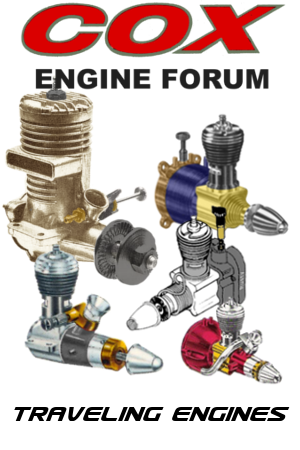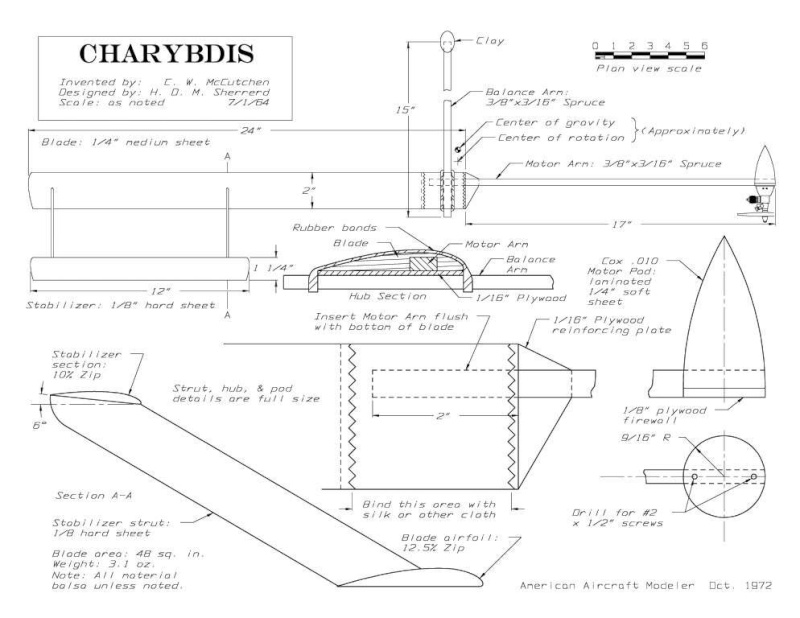Log in
Search
Latest topics
» A choke-tube with velocity-stack configured Beeby roddie Yesterday at 10:35 pm
» Jim Walkers FireBee - This is going to be fun
by MauricioB Yesterday at 10:28 pm
» Prayers for my Wife Please
by MauricioB Yesterday at 9:55 pm
» Jim Walker Firebaby
by rsv1cox Yesterday at 6:33 pm
» Cox prop rod
by Wiggy Yesterday at 4:30 pm
» WenMac 049 - Glow Plug & Head Gasket replacements?
by mike in SC Yesterday at 3:04 pm
» Hawk had breakfast and then took a bath
by akjgardner Yesterday at 10:34 am
» "Red Neck" .049 elec. starter
by getback Yesterday at 7:19 am
» Prop Rod - resto to a runner
by getback Yesterday at 7:16 am
» Cox prop rod
by Wiggy Yesterday at 5:35 am
» Looking For Comet Tri-Pacer
by latole Yesterday at 3:45 am
» Cox AT-6 Texan repaint.....Pretty nice
by latole Yesterday at 3:20 am
McCutchen Wing AKA Charibdis
Page 1 of 1
 McCutchen Wing AKA Charibdis
McCutchen Wing AKA Charibdis
Or sometimes Charybdis (illiteration for wirlpool of GreeK Mythology)
It is a single bladed free flight helicopter, with no moving parts outside the engine. Inspired no doubt by a maple-seed.
20 odd years ago I was brousing the literature rack in the LHS and saw Ken Willard's "8 Easy Projects for 1/2A Engines". This thing was in there, Ken called it the "Rotoriser". I had to build one. Little did I know how long it would take me to get around to it. I failed to buy the book, and never saw it again. There are plans all over the internet now, but recall that this was 20 years ago, and things were not so simple.
I think someone on this forum recalled the name of the book, and I found a copy on Alibris. I doubt it will be back in print. I made a few changes, probably not needed, but it flew pretty good on it's maiden flight Saturday, so I don't guess I screwed up Ken's design too much.
Enough with the Blah, blah blah, here is the basic layout:

In flight, the whole thing spins. The engine is a tractor, and pulls itself and the wing around the center of gravity, which is near the inboard end of the wing. The small stick is a flybar /balance mass /dynamic stabilizer.
Here is a shot from the wingtip, showing the stabilizer and struts that support it. The stabilizer lifts the balance mass against gravity and dynamic forces which try to keep it in-plane. This gives the wing positive pitch and allows it to lift the machine. The flybar and stabilizer serve to govern the rotor speed.

The engine not only supplies power to fly the thing, but serves as a counterbalance mass. This bee has a drilled out intake (5/64") and a killer bee piston/cylinder, as well as a Davis Diesel crank. It turns the 5x3 cox prop at 16,800 rpm on the test stand, 25% nitro glowboy fuel. If that seems lame, consider this was on a hot afternoon at 5000' elevation. A stock baby bee will turn that prop only about 13,500 rpm where I live, and only if it is a good one.
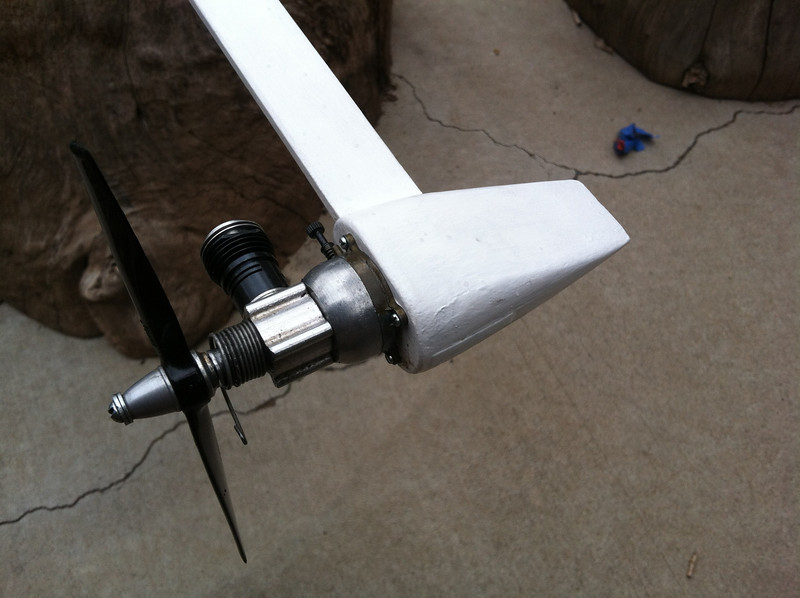
Ken designed the thing for a stock baby bee, but living at altitude has taught me to want a little extra power over what worked at sea level. After flying it, I think a stock BB would be fine as long as you hit the needle setting right, which is difficult, as the G loading leans the mixture when the rotor spins up.
This engine orientation protects the needle and cylinder, and allows plenty of fuel for the short engine runs appropriate for free flight models.
Here is a shot of my crude balance mass. I added those disks to the arms intending to wrap solder on there for balance. Then I couldn't find my large 50/50 solid core plumbing solder, and didn't want to waste the expensive rosin core 63/37 electronic solder. I will come up with something neater, but this worked fine for the maiden flight.
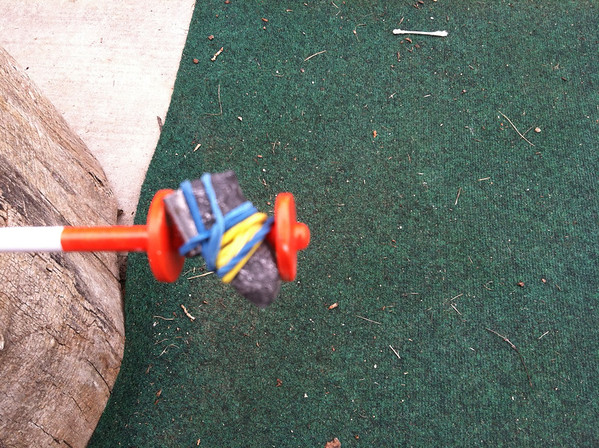
One thing I really didn't like about Ken's design was how the booms weaken the TE where they slot into it. The wing is made from 1/4" sheet, but it is airfoiled, and less than half that at the TE. I added some 1/32" ply scabs underneath to spread the load, and restore the strength lost to the slots.
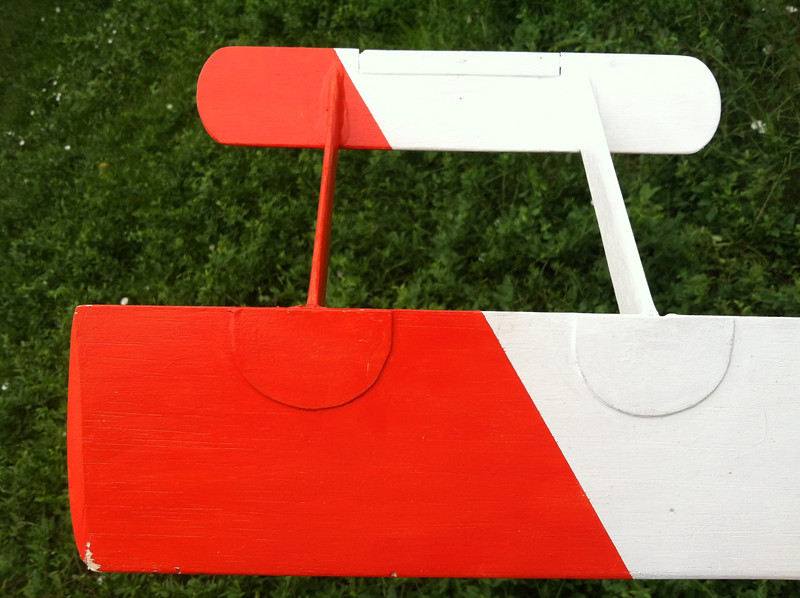
I'll add to this thread later. I plan to post enough info to build either Ken's original version, or what I made, as well as thoughts on what I'll change for the next one...the thing is a lot of fun to fly.
It is a single bladed free flight helicopter, with no moving parts outside the engine. Inspired no doubt by a maple-seed.
20 odd years ago I was brousing the literature rack in the LHS and saw Ken Willard's "8 Easy Projects for 1/2A Engines". This thing was in there, Ken called it the "Rotoriser". I had to build one. Little did I know how long it would take me to get around to it. I failed to buy the book, and never saw it again. There are plans all over the internet now, but recall that this was 20 years ago, and things were not so simple.
I think someone on this forum recalled the name of the book, and I found a copy on Alibris. I doubt it will be back in print. I made a few changes, probably not needed, but it flew pretty good on it's maiden flight Saturday, so I don't guess I screwed up Ken's design too much.
Enough with the Blah, blah blah, here is the basic layout:

In flight, the whole thing spins. The engine is a tractor, and pulls itself and the wing around the center of gravity, which is near the inboard end of the wing. The small stick is a flybar /balance mass /dynamic stabilizer.
Here is a shot from the wingtip, showing the stabilizer and struts that support it. The stabilizer lifts the balance mass against gravity and dynamic forces which try to keep it in-plane. This gives the wing positive pitch and allows it to lift the machine. The flybar and stabilizer serve to govern the rotor speed.

The engine not only supplies power to fly the thing, but serves as a counterbalance mass. This bee has a drilled out intake (5/64") and a killer bee piston/cylinder, as well as a Davis Diesel crank. It turns the 5x3 cox prop at 16,800 rpm on the test stand, 25% nitro glowboy fuel. If that seems lame, consider this was on a hot afternoon at 5000' elevation. A stock baby bee will turn that prop only about 13,500 rpm where I live, and only if it is a good one.

Ken designed the thing for a stock baby bee, but living at altitude has taught me to want a little extra power over what worked at sea level. After flying it, I think a stock BB would be fine as long as you hit the needle setting right, which is difficult, as the G loading leans the mixture when the rotor spins up.
This engine orientation protects the needle and cylinder, and allows plenty of fuel for the short engine runs appropriate for free flight models.
Here is a shot of my crude balance mass. I added those disks to the arms intending to wrap solder on there for balance. Then I couldn't find my large 50/50 solid core plumbing solder, and didn't want to waste the expensive rosin core 63/37 electronic solder. I will come up with something neater, but this worked fine for the maiden flight.

One thing I really didn't like about Ken's design was how the booms weaken the TE where they slot into it. The wing is made from 1/4" sheet, but it is airfoiled, and less than half that at the TE. I added some 1/32" ply scabs underneath to spread the load, and restore the strength lost to the slots.

I'll add to this thread later. I plan to post enough info to build either Ken's original version, or what I made, as well as thoughts on what I'll change for the next one...the thing is a lot of fun to fly.

kevbo- Silver Member

- Posts : 91
Join date : 2013-03-05
 What engine to use.
What engine to use.
Since this is the cox ENGINE forum, lets talk about what engine to use on these things:
There are plans on the net for a .010 powered version. I think .049 is about as big as a prudent person would build. Note that this thing is freeflight, and who knows what it will eventually run into. Anything larger and it would need to be two pieces for ease of transport. At 5' or so, mine already barely fits inside the cab of a compact pickup truck. .049 engines are cheap and plentiful.
At the engine rpm I am running, the prop would have zero slip at around 1800 rpm. I am guessing the thing was turning around 2-300 rpm in flight. So the prop never really unloads. If you did some static thrust testing, the engine/prop with the highest static thrust would probably give this thing the best climb.
This is why I think a stock baby-bee would be fine. Those will swing a 6x3 and produce pretty healthy thrust.
You don't need a 5cc tank. A product engine with a small tank would be fine, and maybe work better. (see below) If it is lighter, then you could use a longer engine arm, and this would provide more torque, and still be moving well below the speed needed to unload the prop.
The fuel tank and pickup location is an issue. I used the "RC" pickup location, just to the inside of the tank bolt.
the wing is held vertically to fuel and start the engine. Then it is placed on a launching nail horizontally, and then allowed to spin up and take off. Some thought is required to keep the end of the fuel pickup wet in all three scenarios.
Ken's design just used two hardwood blocks on each side of the engine boom for mounting. I used a 1/8" plywood firewall fibreglassed to balsa cheek blocks, and sanded to a pretty streamlined fairing.
I added some upthrust to the engine (3 degrees estimated), as the engine gets pitched down when the wing pitches up. As well as not helping gravity, the up thrust allows the rotor to run with less cone. Rotor coning does NOT work like dihederal, and actually reduces stability. The full explanation is long, but the short version is that the rotor responds 90 degrees to where you would first assume it would, so a helicopter with a coned rotor responds to slip by pitching up or down rather than by banking as an airplane with dihederal would. Rotor coning can normally not be avoided, but less is always better.
I missed that the prop sits well behind the CG, so the crank is several degrees off tangent. This hurts efficiency a little, but also causes a fuel issue. Because of the way the engine sits with reference to a radial line to the CG, the fuel is forced toward the crankcase rather than the backplate. I plan to add a wedge to correct this, and also mount a wire whisker skid to protect the engine a little. (due to coning, it always lands engine first) Basically, with the engine mounted square to the wing, it becomes harder to gauge the fuel for the desired run time.
Due to the way this thing lands, I would avoid engines with plastic backplates. If you have one that you really want to use, some sort of skid to protect the engine would be wise.
There are plans on the net for a .010 powered version. I think .049 is about as big as a prudent person would build. Note that this thing is freeflight, and who knows what it will eventually run into. Anything larger and it would need to be two pieces for ease of transport. At 5' or so, mine already barely fits inside the cab of a compact pickup truck. .049 engines are cheap and plentiful.
At the engine rpm I am running, the prop would have zero slip at around 1800 rpm. I am guessing the thing was turning around 2-300 rpm in flight. So the prop never really unloads. If you did some static thrust testing, the engine/prop with the highest static thrust would probably give this thing the best climb.
This is why I think a stock baby-bee would be fine. Those will swing a 6x3 and produce pretty healthy thrust.
You don't need a 5cc tank. A product engine with a small tank would be fine, and maybe work better. (see below) If it is lighter, then you could use a longer engine arm, and this would provide more torque, and still be moving well below the speed needed to unload the prop.
The fuel tank and pickup location is an issue. I used the "RC" pickup location, just to the inside of the tank bolt.
the wing is held vertically to fuel and start the engine. Then it is placed on a launching nail horizontally, and then allowed to spin up and take off. Some thought is required to keep the end of the fuel pickup wet in all three scenarios.
Ken's design just used two hardwood blocks on each side of the engine boom for mounting. I used a 1/8" plywood firewall fibreglassed to balsa cheek blocks, and sanded to a pretty streamlined fairing.
I added some upthrust to the engine (3 degrees estimated), as the engine gets pitched down when the wing pitches up. As well as not helping gravity, the up thrust allows the rotor to run with less cone. Rotor coning does NOT work like dihederal, and actually reduces stability. The full explanation is long, but the short version is that the rotor responds 90 degrees to where you would first assume it would, so a helicopter with a coned rotor responds to slip by pitching up or down rather than by banking as an airplane with dihederal would. Rotor coning can normally not be avoided, but less is always better.
I missed that the prop sits well behind the CG, so the crank is several degrees off tangent. This hurts efficiency a little, but also causes a fuel issue. Because of the way the engine sits with reference to a radial line to the CG, the fuel is forced toward the crankcase rather than the backplate. I plan to add a wedge to correct this, and also mount a wire whisker skid to protect the engine a little. (due to coning, it always lands engine first) Basically, with the engine mounted square to the wing, it becomes harder to gauge the fuel for the desired run time.
Due to the way this thing lands, I would avoid engines with plastic backplates. If you have one that you really want to use, some sort of skid to protect the engine would be wise.

kevbo- Silver Member

- Posts : 91
Join date : 2013-03-05
 The Ken Willard Rotoriser Design.
The Ken Willard Rotoriser Design.
The book is still protected by copyright, even though it is out of print and the fact that 3 of the 8 models presented use materials that are no longer available means it is very unlikely to have another printing. It is still a good book, and if you have a chance to pick up an old copy, do so if you love cox engines. So I think the law is dumb, but I will still comply with it and will not post scans of the article.
However, copyright protects the presentation, not the information. So here is dimensional info that should allow you to build a Ken Willard Rotoriser:
Wing: 1/4x4x36" medium hard balsa.
Stabilizer:1/8 x 2 x 10" medium-hard balsa
Motor arm: 1/4 x 1-1/8 x 20-1/2" Basswood, spruce or pine. This is total length of stick, including end that slots into the wing.
Balance arm: Hardwood dowel, 1/4 x 24"
Struts: 3/16 x 1 x ~ 7" hard balsa needed. Rear side length is 6", so both can be cut from one 12" stick if you plan the miters right.
Plywood doubler for wing root: 1/16 x 4 x 4-1/2
Motor mount: Two pieces of hardwood 1/2 x 1-1/2 x 1-1/8" . A nylon mount as used on profile models would work great.
Wing is sanded to a clark-Y-ish airfoil. Mine is flat on top for about an inch of chord, starting about an inch back from LE. I notice the Sig airfoil stock is similar.
The motor arm slots into the center of the wing root for 2-1/2" of span. This joint is reinforced by gluing the 1/16" plywood plate to the lower surface, then fibreglassed both sides for 4-1/2" of span.
Ken just left the tips of the wing and stab square. The wing end of the struts are mitered at 45 degrees. The stab end is mitered at 39 or 51 degrees depending on how you measure, goal is to have the stab sit at -6 to 7 degrees to wing bottom surface. Rear (longer) side of struts is 6".
Struts are slotted into wing. Center of outer slot is 3" from tip, inner slot 8" from tip.
Stab has a 1/2 x 4" trim tab cut out of the rear center. Ken suggests using pipe cleaners for hinges. I used stainless safety wire. Stab glues to top of struts, leading edge flush with front of strut. Center of struts to be 2-1/2" from each tip of stab.
Launching hole is 1" back from leading edge, 1/2" back from wing root. This is initial CG location according to Ken (seems too far aft to me!)
Motor mount blocks are glued to top and bottom of motor arm at outer end. Article shows aluminum sheet angles instead. Plastic mount should work fine. Remember, motor goes opposite direction as wing, so prop driver goes on the TE side.
Balance arm rubber banded to lower surface of wing, 1" from root, 1/4" or so sticking past TE to hook rubber bands on, long end toward LE. Clay or solder on end to balance model per above.
Dope everything several coats for fuel proofing.
I wish I had the above info when I was building. The book has it spread in three different drawings (all at different scales, only one of which are indicated) , some is given in a bill of materials, and some if it is buried in the text. A couple of the dimensions I just guessed at. I think this was Ken's intention. The book has a sort of a "learn to be an aeromodeler in 8 easy lessons" theme, and he figures you should be able to work some things out on your own by the time you get to this model.
However, copyright protects the presentation, not the information. So here is dimensional info that should allow you to build a Ken Willard Rotoriser:
Wing: 1/4x4x36" medium hard balsa.
Stabilizer:1/8 x 2 x 10" medium-hard balsa
Motor arm: 1/4 x 1-1/8 x 20-1/2" Basswood, spruce or pine. This is total length of stick, including end that slots into the wing.
Balance arm: Hardwood dowel, 1/4 x 24"
Struts: 3/16 x 1 x ~ 7" hard balsa needed. Rear side length is 6", so both can be cut from one 12" stick if you plan the miters right.
Plywood doubler for wing root: 1/16 x 4 x 4-1/2
Motor mount: Two pieces of hardwood 1/2 x 1-1/2 x 1-1/8" . A nylon mount as used on profile models would work great.
Wing is sanded to a clark-Y-ish airfoil. Mine is flat on top for about an inch of chord, starting about an inch back from LE. I notice the Sig airfoil stock is similar.
The motor arm slots into the center of the wing root for 2-1/2" of span. This joint is reinforced by gluing the 1/16" plywood plate to the lower surface, then fibreglassed both sides for 4-1/2" of span.
Ken just left the tips of the wing and stab square. The wing end of the struts are mitered at 45 degrees. The stab end is mitered at 39 or 51 degrees depending on how you measure, goal is to have the stab sit at -6 to 7 degrees to wing bottom surface. Rear (longer) side of struts is 6".
Struts are slotted into wing. Center of outer slot is 3" from tip, inner slot 8" from tip.
Stab has a 1/2 x 4" trim tab cut out of the rear center. Ken suggests using pipe cleaners for hinges. I used stainless safety wire. Stab glues to top of struts, leading edge flush with front of strut. Center of struts to be 2-1/2" from each tip of stab.
Launching hole is 1" back from leading edge, 1/2" back from wing root. This is initial CG location according to Ken (seems too far aft to me!)
Motor mount blocks are glued to top and bottom of motor arm at outer end. Article shows aluminum sheet angles instead. Plastic mount should work fine. Remember, motor goes opposite direction as wing, so prop driver goes on the TE side.
Balance arm rubber banded to lower surface of wing, 1" from root, 1/4" or so sticking past TE to hook rubber bands on, long end toward LE. Clay or solder on end to balance model per above.
Dope everything several coats for fuel proofing.
I wish I had the above info when I was building. The book has it spread in three different drawings (all at different scales, only one of which are indicated) , some is given in a bill of materials, and some if it is buried in the text. A couple of the dimensions I just guessed at. I think this was Ken's intention. The book has a sort of a "learn to be an aeromodeler in 8 easy lessons" theme, and he figures you should be able to work some things out on your own by the time you get to this model.
Last edited by kevbo on Mon Aug 12, 2013 3:09 pm; edited 1 time in total

kevbo- Silver Member

- Posts : 91
Join date : 2013-03-05
 Re: McCutchen Wing AKA Charibdis
Re: McCutchen Wing AKA Charibdis
Hmmm. I've got that book in the closet somewhere. Maybe I'll dig it out this weekend.
The Digger Mark
The Digger Mark
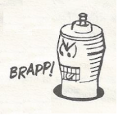
batjac- Diamond Member



Posts : 2338
Join date : 2013-05-22
Age : 61
Location : Broken Arrow, OK, USA
 Re: McCutchen Wing AKA Charibdis
Re: McCutchen Wing AKA Charibdis
Dan Banjock built one of those and flew it at Brodak's fly in last year. He firgured he would try and half tank it. Well, we lost it. It went out of sight and never was recovered. Amazing how high a .049 can put that thing on a solid 15 sec run. Model has never been found to date. They're pretty cool though. Ken

Ken Cook- Top Poster

- Posts : 5485
Join date : 2012-03-27
Location : pennsylvania
 The Kevbo version
The Kevbo version
I limited my changes, as I wanted to be pretty sure it would fly.
I already mentioned the ply scabs under the struts, and the engine mount.
The biggest change was that I increased the effective wing span a little by making the plywood reinforcement plate big enough to locate the lauching hole/CG. This puts the balance arm right at the end of the balsa. Mainly this was driven by my Scots nature...I paid for 36" of wing dagnamnit, I want it all making lift!
I installed the engine with ~3 degrees of upthrust so it would be nearer level in flight. The motor arm was made 1/2" longer to balance the longer wing. I used 1"x1/4" basswood, as no 1-1/8" was available, and I didn't want the hassle of cutting it down. My model balances about a half inch toward the wingtip from my launching hole. I think it will be just right when I add a wedge and skid under the engine backplate.
Square wingtips look ugly and unfinished to me, so I beveled and radiused the wing tip. I increased the span of the elevator by 1/2" and radiused the tips...area should be about the same.
I already mentioned the ply scabs under the struts, and the engine mount.
The biggest change was that I increased the effective wing span a little by making the plywood reinforcement plate big enough to locate the lauching hole/CG. This puts the balance arm right at the end of the balsa. Mainly this was driven by my Scots nature...I paid for 36" of wing dagnamnit, I want it all making lift!
I installed the engine with ~3 degrees of upthrust so it would be nearer level in flight. The motor arm was made 1/2" longer to balance the longer wing. I used 1"x1/4" basswood, as no 1-1/8" was available, and I didn't want the hassle of cutting it down. My model balances about a half inch toward the wingtip from my launching hole. I think it will be just right when I add a wedge and skid under the engine backplate.
Square wingtips look ugly and unfinished to me, so I beveled and radiused the wing tip. I increased the span of the elevator by 1/2" and radiused the tips...area should be about the same.

kevbo- Silver Member

- Posts : 91
Join date : 2013-03-05
 Ideas that I rejected.
Ideas that I rejected.
I considered making a streamlined weight box for the balance mass. The problem is that any lift, up or down, created at that point is going to feather (pitch) the rotor blade, and the angle of the paddle depends on how much the wing is coned which depends on the rotor speed, which depends on the rotor pitch, which is influanced by the paddle. etc. etc. Makes my head hurt.
Some guys have made RC versions(throttle and collective only) and controlling a paddle at the balance mass is easier than driving an elevator on the stabilizer, so it makes sense if you can vary it in flight.
Similar deal with streamlining the motor arm. Since it is rigid, pitching the wing up pitches the arm down. Just no good way to set the angle of an airfoiled motor arm.
Some guys have made RC versions(throttle and collective only) and controlling a paddle at the balance mass is easier than driving an elevator on the stabilizer, so it makes sense if you can vary it in flight.
Similar deal with streamlining the motor arm. Since it is rigid, pitching the wing up pitches the arm down. Just no good way to set the angle of an airfoiled motor arm.

kevbo- Silver Member

- Posts : 91
Join date : 2013-03-05
 Things I will change on the next one
Things I will change on the next one
Engine will be mounted at an angle, so that the crankshaft is tangent at the prop. If a tanked engine is used, this will keep fuel against backplate when craft is spinning. I will test this on the current model by making a wedge to put between the engine backplate and the firewall. The upthrust doesn't seem to be hurting, so I will keep that as well.
I will strongly consider using a horseshoe backplate engine with a pressure bladder. This would solve a number of fuel issues. If I do that, I would probably also use a mechanical timer to kill the engine. As mentioned above, it doesn't take much fuel to fly these OOS.
Struts should be mounted at an angle so that they are tangent at about mid length. Having them square to the wing creates drag, and placeds the stab at an angle to the local airflow. LE of stab should be on radial. Not looking for high performance, (there is no contest class for such things) but less drag should make it come down more gently in autorotation, and that should make the fun last longer. Ideal would be curved struts but they would need to be composite to be strong and light enough, and would be a hassle to make.
The center of the wing is moving so slow that it makes almost no lift. Twisting the wing seems a big hassle, and could screw up auto-rotation. I think the thing to do is extend the motor boom, and eliminate some wing at the root. Arraingments for the launch hole and balance arm mounting would not be too hard to come up with.
The center joint is highly stressed on landing. I think the motor arm should "break" with rubber bands near the root. This would also allow the craft to break down smaller for handier transport.
I will strongly consider using a horseshoe backplate engine with a pressure bladder. This would solve a number of fuel issues. If I do that, I would probably also use a mechanical timer to kill the engine. As mentioned above, it doesn't take much fuel to fly these OOS.
Struts should be mounted at an angle so that they are tangent at about mid length. Having them square to the wing creates drag, and placeds the stab at an angle to the local airflow. LE of stab should be on radial. Not looking for high performance, (there is no contest class for such things) but less drag should make it come down more gently in autorotation, and that should make the fun last longer. Ideal would be curved struts but they would need to be composite to be strong and light enough, and would be a hassle to make.
The center of the wing is moving so slow that it makes almost no lift. Twisting the wing seems a big hassle, and could screw up auto-rotation. I think the thing to do is extend the motor boom, and eliminate some wing at the root. Arraingments for the launch hole and balance arm mounting would not be too hard to come up with.
The center joint is highly stressed on landing. I think the motor arm should "break" with rubber bands near the root. This would also allow the craft to break down smaller for handier transport.

kevbo- Silver Member

- Posts : 91
Join date : 2013-03-05
 The first flight
The first flight
It just dawned on me that I didn't say much about how this flew on the maiden flights.
When I left the house, I was headed out to fly C/L. My preferred C/L location is not suitable for freeflight. It is a large grass playground bordered on three sides by a military reservation (Kirtland AFB/ ABQ international airport). Even if it didn't fly into the land of humorless AP with machineguns, anything flying higher than a C/L plane is probably a hazard to air traffic. We have had V-22s ("Osprey" tilt rotorcraft) come over the flight circle at 500' more than once.
The idea was to hold the McCutchen down using a bicycle spoke and find the needle setting that worked when it was spinning. Turns out it doesn't like to be held down. It starts precessing, and it gets scary when holding it over your head.
While I was hanging on to the thing praying that nothing went horribly wrong before the fuel ran out (of course I filled the tank, silly me) a work crew showed up to fill in the prarie dog holes in the flying field.
So I got on the phone and waved off the other guys that were headed there. We went to the paved city provided flying site on the west side. Lots more room, but the wind is seldom calm out there. We have gotten some rain of late, so the dust was not a problem as it often is.
There was enough wind that I didn't want to chance more than 10-15 seconds of engine run. The marks are gone on my fuel syringe, so I used a spare prop blade as a gauge, and that gave just over a minute run on Bill's stopwatch. He would then time me from startup, and give me a countdown.
I have not yet made a proper launch stand, so I was using the bent bicycle spoke held over head, and letting go when it started to lift.
The first 2 (3??? I forget) flights the engine quit right after launch. These tended to angle off downwind (not just drift) and I worried that the thing would slide in, but it seemed to level itself out and the landings on the asphalt were not too harsh.
Finally, the engine stayed lit, and the machine leveled out within a second or two, and climbed nicely. Bill said I got a 15 second run, but it seemed like at least double that. It got to 3-400 feet I'd guess. With the breeze we had that was about 400 yards for the retrieve.
The wind was freshening, so I opted not to mess with success.
When I left the house, I was headed out to fly C/L. My preferred C/L location is not suitable for freeflight. It is a large grass playground bordered on three sides by a military reservation (Kirtland AFB/ ABQ international airport). Even if it didn't fly into the land of humorless AP with machineguns, anything flying higher than a C/L plane is probably a hazard to air traffic. We have had V-22s ("Osprey" tilt rotorcraft) come over the flight circle at 500' more than once.
The idea was to hold the McCutchen down using a bicycle spoke and find the needle setting that worked when it was spinning. Turns out it doesn't like to be held down. It starts precessing, and it gets scary when holding it over your head.
While I was hanging on to the thing praying that nothing went horribly wrong before the fuel ran out (of course I filled the tank, silly me) a work crew showed up to fill in the prarie dog holes in the flying field.
So I got on the phone and waved off the other guys that were headed there. We went to the paved city provided flying site on the west side. Lots more room, but the wind is seldom calm out there. We have gotten some rain of late, so the dust was not a problem as it often is.
There was enough wind that I didn't want to chance more than 10-15 seconds of engine run. The marks are gone on my fuel syringe, so I used a spare prop blade as a gauge, and that gave just over a minute run on Bill's stopwatch. He would then time me from startup, and give me a countdown.
I have not yet made a proper launch stand, so I was using the bent bicycle spoke held over head, and letting go when it started to lift.
The first 2 (3??? I forget) flights the engine quit right after launch. These tended to angle off downwind (not just drift) and I worried that the thing would slide in, but it seemed to level itself out and the landings on the asphalt were not too harsh.
Finally, the engine stayed lit, and the machine leveled out within a second or two, and climbed nicely. Bill said I got a 15 second run, but it seemed like at least double that. It got to 3-400 feet I'd guess. With the breeze we had that was about 400 yards for the retrieve.
The wind was freshening, so I opted not to mess with success.

kevbo- Silver Member

- Posts : 91
Join date : 2013-03-05
 Some thoughts and pointers for those interested.
Some thoughts and pointers for those interested.
This thing is a true rotorcraft. Perhaps not a helicopter, but it is a rotor and has most of the perverse qualities that made helicopters so hard to make work in the early days.
The balance arm is a flybar as used on many conventional helicopters. It just acts directly on the blade pitch, because without a shaft and rotor head hinges, no linkage is needed.
The balance arm _also_ makes these machines into a plane in the geometric sense. A classic boomerang is bent because if it is straight then it does not define a plane, it is just a line, and a line will not allow the blades to be stable in feather (pitch). Boomerangs can and are made with three identical blades and they work fine. You can fling a three bladed propeller like a frisbee and it will more or less fly, but if you try that with a two bladed prop, it will just tumble. A two bladed prop depends on a rigid crankshaft to keep it stable.
Getting the mass of the blade, the engine, and the balance arm into a big triangle is what makes these spin stably. Any weight is best added at the ends of the three legs, not near the hub. Of course more strength is needed at the hub, so this is a challenge. This is why I think attaching the motor arm with rubber bands would be good. It should allow the hub to be lighter as it will not have to withstand such high landing loads. In addition to defining a bigger plane, having the mass outboard reduces coning, and that is always good.
With available props, the prop will always be running at very high slip. This means the longer the motor arm, the more power you can put into flight. A light weight boom will need to be longer to balance a given wing, so a carbon arrow shaft should be good. The motor is essentially putting out constant thrust. This means that higher rotor rpm also equates to more power. But drag will eventually get you.
Mass outboard of the motor is bad. You could have moved the motor out instead, and gotten more power.
Best to aim to have the machine come out motor heavy before balancing. Since the motor arm is shorter than the wing, it will take more weight at the motor to balance a heavy wing than it will take weight on the wing tip to balance a heavy motor.
The fuel system is tricky, due to the need to be stationary when starting, then spin up to a high G loading. Essentially it is a a C/L plane with 18" lines. Slack bladders or pressure bladders would seem to be a win. I may try to modify the bee tank as uniflow.
The balance arm is a flybar as used on many conventional helicopters. It just acts directly on the blade pitch, because without a shaft and rotor head hinges, no linkage is needed.
The balance arm _also_ makes these machines into a plane in the geometric sense. A classic boomerang is bent because if it is straight then it does not define a plane, it is just a line, and a line will not allow the blades to be stable in feather (pitch). Boomerangs can and are made with three identical blades and they work fine. You can fling a three bladed propeller like a frisbee and it will more or less fly, but if you try that with a two bladed prop, it will just tumble. A two bladed prop depends on a rigid crankshaft to keep it stable.
Getting the mass of the blade, the engine, and the balance arm into a big triangle is what makes these spin stably. Any weight is best added at the ends of the three legs, not near the hub. Of course more strength is needed at the hub, so this is a challenge. This is why I think attaching the motor arm with rubber bands would be good. It should allow the hub to be lighter as it will not have to withstand such high landing loads. In addition to defining a bigger plane, having the mass outboard reduces coning, and that is always good.
With available props, the prop will always be running at very high slip. This means the longer the motor arm, the more power you can put into flight. A light weight boom will need to be longer to balance a given wing, so a carbon arrow shaft should be good. The motor is essentially putting out constant thrust. This means that higher rotor rpm also equates to more power. But drag will eventually get you.
Mass outboard of the motor is bad. You could have moved the motor out instead, and gotten more power.
Best to aim to have the machine come out motor heavy before balancing. Since the motor arm is shorter than the wing, it will take more weight at the motor to balance a heavy wing than it will take weight on the wing tip to balance a heavy motor.
The fuel system is tricky, due to the need to be stationary when starting, then spin up to a high G loading. Essentially it is a a C/L plane with 18" lines. Slack bladders or pressure bladders would seem to be a win. I may try to modify the bee tank as uniflow.

kevbo- Silver Member

- Posts : 91
Join date : 2013-03-05
 Re: McCutchen Wing AKA Charibdis
Re: McCutchen Wing AKA Charibdis
Well, I was able to do some more flying this weekend. and learned a bunch. It was a CL contest weekend, and I brought the wing along to take advantage of the early morning calm conditions. I made a launcher, a piece of wire (bicycle spoke) taped to a garden stake. The brass bushing at the CG slips onto this allowing the wing to lift off once it is turning fast enough.
Friday I had about three good lauches, but the engine would die just after launch. The wing would autorotate to a fairly gentle landing. The last one though, filled the engine with dirt, ending the flying 'till I could work on it.
I realized that the way the engine was mounted, the fuel moves to the front of the bowl when it is spinning.
So when I had the engine torn apart to give it a bath, I arrainged a pickup near the front of the bowl.
This was a bad idea. The fuel moves up there when the wing is spinning alright, but when you first release it on the lauch stand, it has to accelerate and this moves the fuel to the backplate.
With the pickup on the backplate, the thing lauched fine, but sucked air as soon as the rotation reached steady state.
With the pickup at the front of the bowl, it it kept dying after one revolution or so on the launcher, never getting going fast enough to lift off.
So the way the engine is mounted, the fuel moves to the backplate when the machine is spinning up, then to the front of the bowl when it reaches steady state.
It was pretty calm, so I put about 90 seconds worth of fuel into it and was able to get a couple of nice flights. On the first of these, I misjudged the needle and the engine was down on power. This allowed the wing to cross over the whole parking lot at 10-20 feet. The engine didn't want to fire up after that, untill I replaced the glowhead. I didn't have another high compression (TD) head, so I used a normal one. I hit the mixture pretty well on the next flight, and it went high, then started surging, but not really losing altitude. The wind was very light so it only went a couple hundred yards.
On both of these flights I could have caught the model if there was a good safe way to do so. Will have to think on that.
I decided that moving the pickup to the backplate, and wedging the mounting would help the fuel situation. This should keep the fuel at the backplate both on acceleration, and steady state. It also puts the crankshaft more nearly tangent to the rotation, which should be better. I also was able to fit a skid under the wedge to hopefully help keep the engine out of the dirt. I decided a rubber spinner would add some helpful weight, and also further the protect the engine theme. (I'll add a photo later, check back Edit: Done!). The 5x3 cox prop had a few dings, so I replaced it with one of the safety tip ones I got from Bernie.
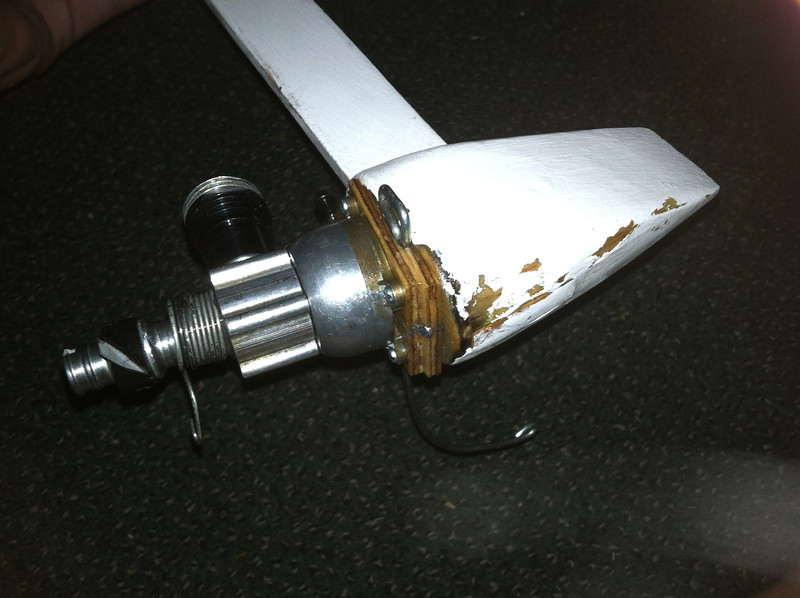
So I was pretty hopeful Sunday morning. The first launch spun right up without dying, and spun, and spun and spun, and never got off the launcher. The engine was definatly not making near the power it had been. It was smooth, but the rpm was way down. I tweaked the needle a little, and the next run finally got off the launcher, and then lost some power and made a very gentle landing on the pavement, until the wing came to rest and the prop tipped into the pavement. The prop shed both blades and the engine went into a crank run. WOW! never heard a cox do that before. Good thing I had the Davis crank snd light piston in this one. Sounded like a mosquito almost, only really loud. The spinner shot off into the weeds somewhere.
I was worried that the engine was hurt by the crank run, so I put the only prop I had with me on, a MA 6x3. This acually got the thing airborn till the engine quit. So the engine just did not like that safety tip prop (but see below)
After the one short flight with the 6x3 I noticed the wing had a spanwise split, so I packed it in for the day. I had another look in the afternoon, and actually found the spinner in the weeds. Maybe I should plan a trip to Las Vegas??
At home, while the glue was drying on the wing, I thought a bit more about how the engine ran with that safety tip prop, and it just made no sense to me that there would be that much difference...power to spare with the one 5x3, and totally lame with the fat tips.
Then I realized there was one other thing different besides the prop....that spinner. Could that be it? Nah, it is just a hunk of rubber. Now it was a different glowhead, but it flew fine on the new glowhead the day before, so that probably wasn't the problem.
Well since I had found the spinner, and I had another safety tip prop at home, so I could test it. With the spinner on the engine only wound up to 15,000 for a second or two, but was mostly in the high 14 s.
Popping the spinner off got me well north of 17,000! I actually saw 17,300 briefly, and 17,100-200 steady. WOW! 16,800 was the best I had seen with the old prop and glowhead.
I wanted to repeat this, and found out my glowplug clip was flaky. (probably why I had to change out the glowhead earlier in this post) So I used some alligator clamps and got it to fire right up, but couldn't get it to hold a needle setting either with or without the spinner.
Then I noticed the needle seat insert was coming out of the backplate. Probably got shook loose on the crank run. Or maybe the ultrasonic cleaner I used after the friday dirt bath did it? I was able to run a tank out by holding the needle down with my finger.
I am wondering If anyone has tried putting one of these back with JB weld? of course I would need to get it very clean and oil free first. I drilled out this backplate, and I really don't want to modify a second one...metal backplates are not that easy to come by these days.
Anyway, I thought I would add to the body of knowlege, that there is at least one case of a rubber spinner killing performance, weird as it seems.
The control line speed guys swear the pans increase power by providing a rigid mounting for the engine. Maybe having a chunk of high damping material mounted to the crank soaks up power somehow??
Friday I had about three good lauches, but the engine would die just after launch. The wing would autorotate to a fairly gentle landing. The last one though, filled the engine with dirt, ending the flying 'till I could work on it.
I realized that the way the engine was mounted, the fuel moves to the front of the bowl when it is spinning.
So when I had the engine torn apart to give it a bath, I arrainged a pickup near the front of the bowl.
This was a bad idea. The fuel moves up there when the wing is spinning alright, but when you first release it on the lauch stand, it has to accelerate and this moves the fuel to the backplate.
With the pickup on the backplate, the thing lauched fine, but sucked air as soon as the rotation reached steady state.
With the pickup at the front of the bowl, it it kept dying after one revolution or so on the launcher, never getting going fast enough to lift off.
So the way the engine is mounted, the fuel moves to the backplate when the machine is spinning up, then to the front of the bowl when it reaches steady state.
It was pretty calm, so I put about 90 seconds worth of fuel into it and was able to get a couple of nice flights. On the first of these, I misjudged the needle and the engine was down on power. This allowed the wing to cross over the whole parking lot at 10-20 feet. The engine didn't want to fire up after that, untill I replaced the glowhead. I didn't have another high compression (TD) head, so I used a normal one. I hit the mixture pretty well on the next flight, and it went high, then started surging, but not really losing altitude. The wind was very light so it only went a couple hundred yards.
On both of these flights I could have caught the model if there was a good safe way to do so. Will have to think on that.
I decided that moving the pickup to the backplate, and wedging the mounting would help the fuel situation. This should keep the fuel at the backplate both on acceleration, and steady state. It also puts the crankshaft more nearly tangent to the rotation, which should be better. I also was able to fit a skid under the wedge to hopefully help keep the engine out of the dirt. I decided a rubber spinner would add some helpful weight, and also further the protect the engine theme. (I'll add a photo later, check back Edit: Done!). The 5x3 cox prop had a few dings, so I replaced it with one of the safety tip ones I got from Bernie.

So I was pretty hopeful Sunday morning. The first launch spun right up without dying, and spun, and spun and spun, and never got off the launcher. The engine was definatly not making near the power it had been. It was smooth, but the rpm was way down. I tweaked the needle a little, and the next run finally got off the launcher, and then lost some power and made a very gentle landing on the pavement, until the wing came to rest and the prop tipped into the pavement. The prop shed both blades and the engine went into a crank run. WOW! never heard a cox do that before. Good thing I had the Davis crank snd light piston in this one. Sounded like a mosquito almost, only really loud. The spinner shot off into the weeds somewhere.
I was worried that the engine was hurt by the crank run, so I put the only prop I had with me on, a MA 6x3. This acually got the thing airborn till the engine quit. So the engine just did not like that safety tip prop (but see below)
After the one short flight with the 6x3 I noticed the wing had a spanwise split, so I packed it in for the day. I had another look in the afternoon, and actually found the spinner in the weeds. Maybe I should plan a trip to Las Vegas??
At home, while the glue was drying on the wing, I thought a bit more about how the engine ran with that safety tip prop, and it just made no sense to me that there would be that much difference...power to spare with the one 5x3, and totally lame with the fat tips.
Then I realized there was one other thing different besides the prop....that spinner. Could that be it? Nah, it is just a hunk of rubber. Now it was a different glowhead, but it flew fine on the new glowhead the day before, so that probably wasn't the problem.
Well since I had found the spinner, and I had another safety tip prop at home, so I could test it. With the spinner on the engine only wound up to 15,000 for a second or two, but was mostly in the high 14 s.
Popping the spinner off got me well north of 17,000! I actually saw 17,300 briefly, and 17,100-200 steady. WOW! 16,800 was the best I had seen with the old prop and glowhead.
I wanted to repeat this, and found out my glowplug clip was flaky. (probably why I had to change out the glowhead earlier in this post) So I used some alligator clamps and got it to fire right up, but couldn't get it to hold a needle setting either with or without the spinner.
Then I noticed the needle seat insert was coming out of the backplate. Probably got shook loose on the crank run. Or maybe the ultrasonic cleaner I used after the friday dirt bath did it? I was able to run a tank out by holding the needle down with my finger.
I am wondering If anyone has tried putting one of these back with JB weld? of course I would need to get it very clean and oil free first. I drilled out this backplate, and I really don't want to modify a second one...metal backplates are not that easy to come by these days.
Anyway, I thought I would add to the body of knowlege, that there is at least one case of a rubber spinner killing performance, weird as it seems.
The control line speed guys swear the pans increase power by providing a rigid mounting for the engine. Maybe having a chunk of high damping material mounted to the crank soaks up power somehow??
Last edited by kevbo on Wed Aug 21, 2013 5:11 pm; edited 1 time in total (Reason for editing : Added photo)

kevbo- Silver Member

- Posts : 91
Join date : 2013-03-05
 Re: McCutchen Wing AKA Charibdis
Re: McCutchen Wing AKA Charibdis
Nicely done report.kevbo wrote:................Anyway, I thought I would add to the body of knowlege, that there is at least one case of a rubber spinner killing performance, weird as it seems.
It's really not that weird. Years back, there was a spinner available that actually pressed onto the rubber spinner shipped with COX engines. I got one because it was a larger diameter and I thought it would compliment the plane it was on. The engine started easily, ran consistently, but was "slow".
Assuming that the engine is well tuned, what external factors limit speed.
1. The amount of "work" being done which is tied to the volume and velocity of the air being moved -- this is related the prop diameter and pitch.
2. Parasitic drag on the blades -- this goes up with square of the velocity of the prop blade itself.
3. Rotational mass -- how much mass must be accelerated with each power stroke.
The only way I can think of to explain the effect of rotating mass is by example. If you had a 27" racing bicycle wheel and tire and a 27" heavy truck tire each mounted on axles with equivalent bearing resistance, which could you spin faster by hitting the tread with the palm of your hand? Because the truck tire is much heavier, a lot energy is expended just getting all the weight moving vs. the bicycle wheel which spins up easily.
I think relatively heavy spinners on small engines have the same limiting effect -- energy is used up just maintaining speed on the spinner mass and doesn't transfer to higher prop rpms.
But......, I would welcome any other comments or explanations.
 Re: McCutchen Wing AKA Charibdis
Re: McCutchen Wing AKA Charibdis
Found this video on YouTube while looking for other stuff:
The Browsing Mark
The Browsing Mark

batjac- Diamond Member



Posts : 2338
Join date : 2013-05-22
Age : 61
Location : Broken Arrow, OK, USA
 Similar topics
Similar topics» EXTREMELY RARE COX THIMBLE DROME PROTOTYPE "BLACK WIDOW" GAS MODEL AIRPLANE
» Charybdis-a free-flight model
» Older Brothers
» I need help
» Well, I got the wing on it ;>~
» Charybdis-a free-flight model
» Older Brothers
» I need help
» Well, I got the wing on it ;>~
Page 1 of 1
Permissions in this forum:
You cannot reply to topics in this forum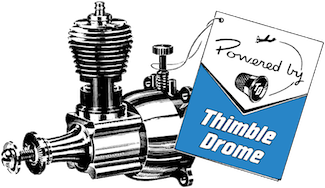

 Rules
Rules


